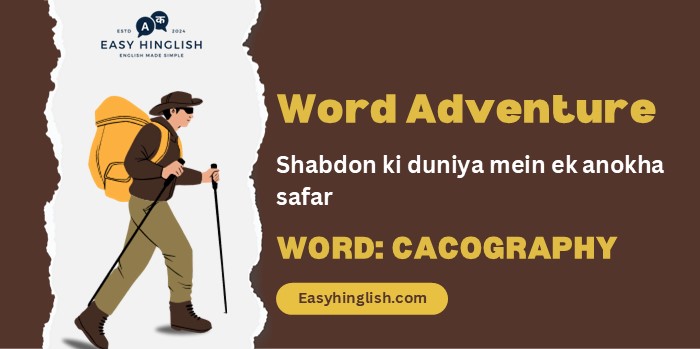Word Adventure: Cacography
The Headline
“Cacography: Jab Letters Rebel Kar Jaayein Aur Words Go Wild”
The Scoop
Language aur communication ki realm mein, perfection often elude karta hai hume. ‘Cacography’ ek delightfully specific term hai jo puts a name to something jo many of us ne encounter kiya hai – frustrating yet sometimes amusing world of poor handwriting aur incorrect spelling. Mere saath chaliye as we explore this term jo validate karta hai struggles of teachers marking papers, friends deciphering hasty notes, aur anyone jo kabhi receive kiya hai text message jo autocorrect ne thoroughly mangle kar diya ho.
Let’s Break It Down
The Plot Thickens
‘Cacography’ combine karta hai two Greek elements: ‘kakos’, meaning “bad,” aur ‘graphein’, meaning “to write.” Yeh hai direct opposite of ‘calligraphy’ (from Greek ‘kallos’, meaning “beauty”), setting up ek perfect linguistic contrast between writing jo aesthetically pleasing hai aur writing jo, well, nahi hai.
Interestingly, cacography ka hai dual meaning. Yeh refer kar sakta hai illegible handwriting ko – woh almost hieroglyphic scrawls jo challenge karte hain even the most determined reader ko. But yeh encompass bhi karta hai poor spelling aur grammar, making it applicable to digital age jahan handwriting may be less common but spelling errors abound karte hain.
Throughout history, cacography raha hai both lamented aur deliberately employed. Teachers aur editors ne long struggle kiya hai against it, jabki kuch authors aur linguists ne intentionally use kiye hain cacographic examples to highlight common errors ya document the evolution of spelling. 19th century mein, education manuals sometimes included karte the “cacography exercises” jahan students ko present kiye jaate the incorrectly spelled passages to correct – ek early version of proofreading exercises jo still use hote hain today.
Word in the Wild
The Twist
Yahan something deliciously ironic hai cacography ke baare mein: history ke kuch greatest writers aur thinkers the notorious for it! Jane Austen ke manuscripts reveal karte hain inconsistent spelling jo would raise eyebrows today. F. Scott Fitzgerald rely karte the heavily on editors to correct his spelling errors. Even Albert Einstein ka handwriting tha famously difficult to decipher. Yeh suggest karta hai intriguing disconnect between mechanical aspects of writing aur brilliance of content. Perhaps more surprisingly, research indicate karta hai ki people with messy handwriting often think faster, with their hands struggling to keep pace with their racing minds. Kuch studies even suggest karte hain correlations between certain types of cacography aur creativity. So next time jab koi point out kare aapki spelling error ya struggle kare to read your handwriting, you might just be in distinguished company!
Make It Stick
Cacography: Jab aapka pen can’t keep up with your brain, ya aapki spelling takes creative detour!
Your Turn
Socha hai kabhi apne experiences ke baare mein cacography ke saath – either as its creator ya its interpreter? Kya hai aapki notoriously challenging handwriting? Struggle kiya hai kabhi to decipher someone else’s scribbles? Perhaps aapki koi recurring spelling error hai jo autocorrect never catch karta, ya aapne receive kiya hai koi message so thoroughly misspelled ki detective work laga understand karne mein? Share kijiye apne cacographic adventures comments mein. Let’s celebrate those moments jab communication persist karta hai, even jab mechanics of writing go delightfully awry!
Down the Rabbit Hole
- Curious hain science behind handwriting ke baare mein? Explore kijiye “graphology,” “cognitive aspects of writing,” ya “dysgraphia” (condition jo affect karti hai writing ability).
- Interested hain history of spelling mein? Research kijiye “spelling standardization,” “spelling reform movements,” ya “orthographic evolution in English.”
- Discover karna chahte hain intentional forms of unconventional writing? Look into kijiye “concrete poetry,” “e. e. cummings’ stylistic choices,” ya “avant-garde typography.”
The Last Word
Jaise hum conclude kar rahe hain apne journey through wonderfully imperfect world of ‘cacography,’ main hope karta hun ki aapne gain ki hai appreciation is term ke liye jo acknowledge karti hai our human struggles with mechanics of writing. Chahe manifested ho as challenging handwriting ya creative spelling, cacography remind karti hai hume ki communication ultimately hai about connection, not perfection. Next time jab aap find kijiye yourself ko squinting at illegible handwriting ya puzzling over misspelled text, remember kijiye ki yeh imperfections hain part of our shared human experience with language. Until our next word adventure, yeh Prashant from Wordpandit, encouraging you to embrace both beauty of calligraphy aur authentic humanity of cacography in your linguistic journey!








